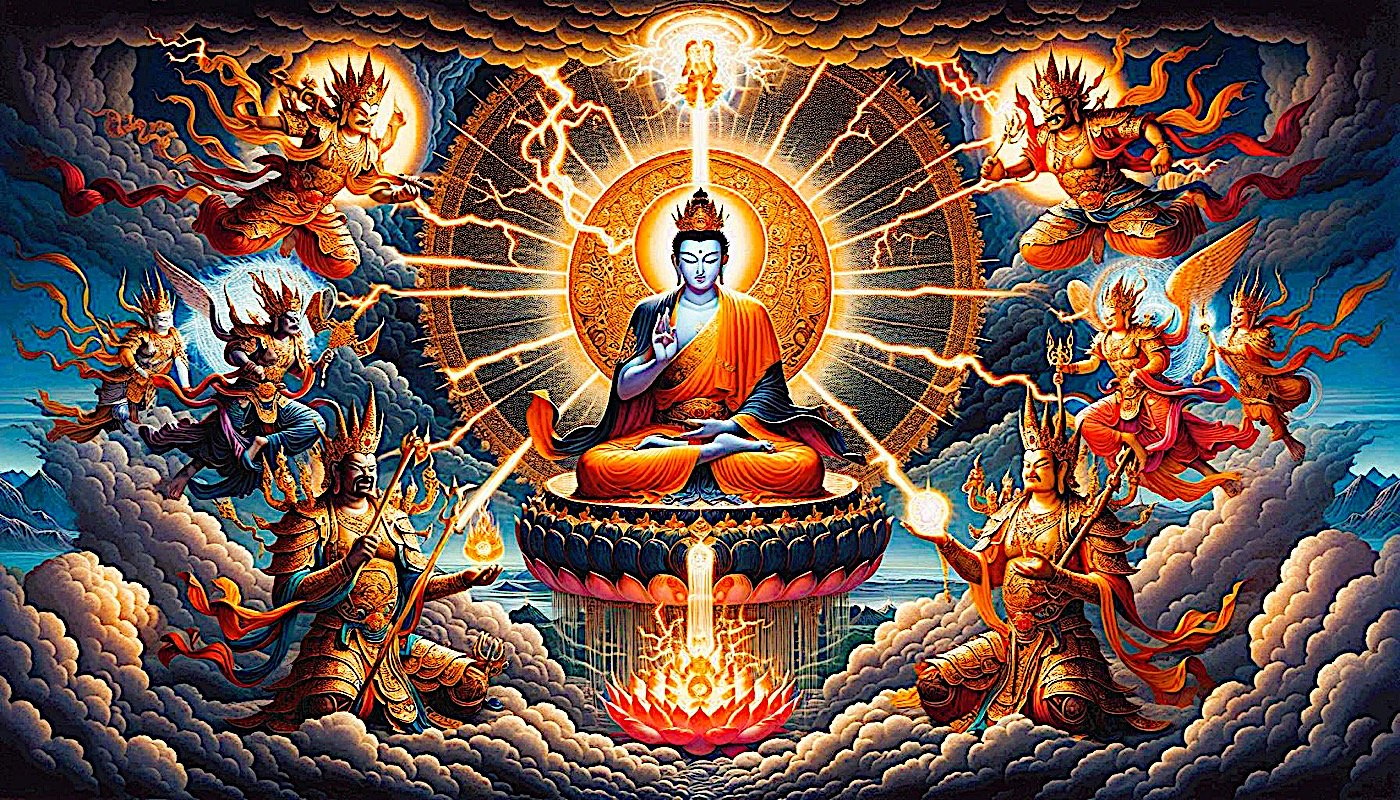The Logic of Not-self
Thanissaro Bhikkhu, featured author in the Summer 2023 "Power & The Practitioner" issue of Buddhadharma, explores the Buddha’s teachings on how a sense of self is formed, how we use the five aggregates to define the self, and how...

Thanissaro Bhikkhu, featured author in the Summer 2023 “Power & The Practitioner” issue of Buddhadharma, explores the Buddha’s teachings on how a sense of self is formed, how we use the five aggregates to define the self, and how to deconstruct the process.
In his second recorded discourse (Mv 1:6.38–47), the Buddha taught that the five aggregates—form, feeling, perception, thought-fabrications, and consciousness—are not-self. This was a statement he was to repeat many times during the 45 years that he taught. Obviously, he had his reasons for making it. The question is, what kind of reasons were they?
One common modern explanation is that he wanted, in an indirect way, to take a position on the question of whether there is a self, along with such related questions as: What are you? Do you even exist?
According to this explanation, the Buddha treated the issue of the existence or non-existence of the self as a problem of deductive logic—arguing from definitions and general principles to their logical conclusion. But the Buddha’s own analysis of how we create and use our sense(s) of self shows that in teaching not-self, he was employing a logic of a more pragmatic and much more effective sort.
The deductive proof of not-self usually goes something like this:
Major premise: To be a self, something must be permanent.
Minor premise: “What you are” is nothing but the five aggregates, none of which are permanent.
Conclusion: Therefore, you have no self.
This conclusion is sometimes followed with a corollary: If you persist in holding to a self, it’s because you refuse to listen to logic.
The whole proof, though, is very weak, both on its own merits and in terms of how it’s supposed to function in the Buddha’s teachings. When we check the Pali Canon—the earliest extant record of what the Buddha taught—we find that he never used this proof. But before we look into the arguments he did use to explain not-self, it’s worth exploring the weaknesses of the deductive proof to show why the not-self teaching, if it’s going to be convincing, needs a stronger foundation than the proof can provide.
To begin with, on its own merits, the proof starts with a general principle that’s totally arbitrary. Many people, from before the Buddha’s time up to the present, have defined the self as impermanent, so the argument would have no impact on them at all. The Buddha himself noted that doctrines of this sort were taught at his time (DN 1; DN 15), so if he had wanted to assume that “self” had to mean “permanent self,” he would have had to offer his reasons for assuming so. But he never did.
Second, in terms of how the proof is supposed to function in the Buddha’s teachings, it’s hard to see what would be accomplished by insisting that the self has to be permanent or that “what you are” is a bundle of the five aggregates. The actual function of the not-self teaching can be seen from its context. The second recorded discourse ends with the note that the listeners gained full awakening because their minds were freed from clinging. And in the first recorded discourse (Mv 1:6.17–31)—in which the Buddha taught the four noble truths to the same group of listeners—we learn in the first noble truth that suffering boils down to clinging to the aggregates and that it can be ended when, through dispassion, the causes of clinging are completely abandoned.
So, the Buddha found that to avoid falling in with the eternalists or annihilationists, he had to be a strategist. Rather than focus on the existence or non-existence of the self, he focused on the real problem: the actions by which a sense of self is formed and becomes an object of clinging—what he called “I-making” and “my-making”
This is precisely where the deductive proof would actually get in the way of carrying out the Buddha’s instructions. The not-self teaching is meant to lead to awakening by inducing dispassion for any act of clinging to the five aggregates. But to identify “what you are” as the aggregates would simply give you more reason to cling to them. Even though they’re impermanent, you would have nothing and be nothing without them, so you might as well hold on to what you’ve got. In fact, a heightened awareness of how insubstantial and precarious “what you are” is would easily give you all the more reason to hold on tight and to protect what you are at all costs, even if it meant having to dance with what is constantly morphing in your grasp.
So, when people continue to hold on to their sense of self in the face of the deductive proof, it’s not because they’re being illogical. They simply have their pragmatic reasons for holding on. They’re making a value judgment: Given what they see as the available options, the pleasures offered by the five aggregates are worth the effort of clinging to them, despite their limitations.
In fact, this value judgment is what the Buddha’s actual not-self rationale is designed to attack, by pointing out that there is another option for happiness, and that it offers pragmatic reasons for why letting go of any sense of self in the aggregates would actually offer more long-term pleasure and happiness than is possible by holding on.
The Buddha approaches the issue of self first by avoiding any position on the question of what the self might be and whether it exists. As he told a group of monks, questions such as “What am I?” “Do I exist?” “Do I not exist?” aren’t worth paying any attention to because they lead to a “thicket of views” that can get you so entangled that you can’t get out (MN 2). And as he told Ven. Ananda (SN 44:10), to take a position on the question of the existence of the self actually gets in the way of following the path to overcome clinging. If you say there is a self, you side with the eternalists, those who teach that the self lasts throughout time. What this seems to mean is that regardless of how you define yourself, you’re like the eternalists in that you tend to cling to whatever you identify as “you.” If you say there is no self, you fall in with the annihilationists, who taught that after death, you no longer remain to receive the results of your actions—a teaching that discourages the effort needed to practice the path to the end of clinging. If you’re not going to be around to experience the results of your efforts, why bother?
So, the Buddha found that to avoid falling in with the eternalists or annihilationists, he had to be a strategist. Rather than focus on the existence or non-existence of the self, he focused on the real problem: the actions by which a sense of self is formed and becomes an object of clinging—what he called “I-making” and “my-making” (MN 72). Rather than try to define you as the five aggregates, he zeroed in on the process by which you use the five aggregates to define yourself, his purpose being to show you how to deconstruct the process.
He noted that people have formulated many different senses of self—finite, infinite, permanent, impermanent, cosmic, individual—but in every instance the sense of self is an assumption about aggregates, and it’s fabricated out of aggregates (SN 22:81). As with every other fabrication, it’s put together for the sake of a desired end (SN 22:79). In other words, it’s a strategy for pleasure and happiness. We identify with our body, for example, both as a producer and as a consumer of pleasures. We can use it to find food; when it eats, we can enjoy the pleasant feelings it can create. The same principle holds for the remaining aggregates. Our thoughts and perceptions help us navigate through the world; satisfying thoughts and perceptions give us happiness in and of themselves.
The Buddha doesn’t deny that the aggregates provide these pleasures (SN 22:60). He simply points out that they also inevitably entail pain. Because every assumption of a self, no matter how the self is defined, is made of aggregates, every act of assuming a self entails some suffering. And because the aggregates are inconstant, simply arising and passing away, even more changeable and unstable than a self annihilated only at death, you can’t just assume a self once and for all and be done with the process. You have to keep on assuming selves without respite.
Again, this would simply have to be accepted if there were no other options for happiness. But as the Buddha pointed out in his first teaching, the four noble truths, there is another option: the third noble truth, the happiness of nibbana. In fact, the logic of not-self is so dependent on this option that it wouldn’t work outside of the context of the four noble truths.
Because nibbana can be experienced only when fabrication ends, we can attain it only when we’ve learned how to overcome our addiction to the desire and passion that fuel fabrication. The first step in the cure is to see all these processes in action. This is why we meditate, constructing mindfulness and states of concentration out of the aggregates (AN 9:36). This sensitizes us to what the aggregates are—activities (SN 22:79)—and to how they work. In particular, we realize the active role we play in shaping them, not only in meditation but also in daily life.
Paradoxically, the mastery of concentration involves developing a healthy sense of self as a meditator, both because you have to be responsible for doing the meditation and because you have to anticipate that you’ll benefit from it. But the paradox is something of a set-up. Once you’ve grown attached to the pleasure of concentration and have used it to dis-identify with unskillful mental states and unskillful senses of self, the Buddha has you turn your heightened sensitivities on the concentration itself (AN 9:36).
If you say there is a self, you side with the eternalists, those who teach that the self lasts throughout time. What this seems to mean is that regardless of how you define yourself, you’re like the eternalists in that you tend to cling to whatever you identify as “you.” If you say there is no self, you fall in with the annihilationists, who taught that after death, you no longer remain to receive the results of your actions—a teaching that discourages the effort needed to practice the path to the end of clinging.
This is where he supplements the four noble truths with three further steps: seeing the allure of the aggregates—why you fall for them—seeing their drawbacks and, when seeing that the drawbacks far outweigh the allure, finally gaining escape from them through dispassion (SN 22:57).
The step of focusing on the drawbacks is where the perception of not-self comes into play, together with the perceptions of inconstancy and stress. The Buddha has you focus on the inconstancy of the aggregates, watching them arising and passing away, to observe two things: (1) They aren’t totally under your control. If they really were you or yours, you could have a body, feelings, etc., exactly as you wanted them—but you can’t (SN 56:11). (2) If they were your self, you’d arise with them, so it’d be impossible to watch them arise. Similarly, you’d pass away with them, making it impossible to see them pass away (MN 148). So, for these two reasons, these building blocks for your sense of self can’t possibly be what you are.
But rather than getting you sidetracked into the question of what is actually watching them, the Buddha has you focus on the stressfulness of the aggregates, until it hits home that even though you play a role in shaping them, they turn around to bite you (SN 22:79). When compared to the possibility of an unchanging, effortless, deathless, happiness, they’re simply not worth the effort that goes into shaping them and identifying with them as “me” or “mine.”
In this way, the Buddha gives you reasons to reverse your earlier value judgment, for the sake of your long-term welfare and happiness (MN 22; SN 35:101). Acts of clinging to the aggregates, using them to create a self for the sake of finding happiness, may work in the short term, but in the long term they actually get in the way of the highest happiness possible. Even clinging to the deathless—something that happens at the lower levels of awakening (AN 9:36)—would get in the way of fully awakening to the reality of the third noble truth, which is why the Buddha doesn’t simply say that the aggregates are not-self. All phenomena, fabricated and not, are to be seen as not-self (MN 35) for the sake of the truest happiness. Because acts of clinging defeat their purpose, no matter where they’re focused, they’re not worth the effort that goes into them. That effort makes no sense.
That’s the logic of not-self. It’s not a deduction from definitions or general principles, negating only the idea of a permanent self. Instead, it’s a pragmatic reasoning—based on taking the third noble truth seriously—that shows how I-making and my-making are, ultimately, counterproductive in the pursuit of happiness, no matter how the “I” and “my” are defined. Because the desire for happiness was the whole reason for engaging in those processes to begin with, this pragmatic reasoning puts an end to any desire and passion for them. And because desire and passion were the motive force behind the processes, the processes can be allowed to cease.
But when you’ve brought the strategies of “self” to an end, you don’t have to keep engaging in the strategy of not-self. When that strategy has done its job, the job is done. You’ve found a happiness that doesn’t need strategies to maintain it, so all strategies—which are fabrications anyhow—can finally be put aside.
When even the path is relinquished, there comes an experience of a dimension totally beyond the six senses and outside of the dimensions of space and time. The Buddha calls this “consciousness without surface”: The image is of a light beam that doesn’t land on any surface at all (DN 11; MN 49; SN 12:64). Some people have suggested that the concept of this consciousness isn’t in line with the teaching on not-self, in that it sounds like a crypto-eternal self, but as the Buddha points out, when all experience of the six senses ceases, there is no thought, “I am” (DN 15). So, concepts of self and not-self don’t apply. And, as we’ve already noted, it’s precisely because the unchanging happiness of this consciousness is possible that the logic of not-self works in the first place. So, instead of conflicting with the teaching on not-self, the concept of this consciousness is a necessary precondition for it.
After the mind returns to the experience of the six senses, it makes use of fabrications to navigate through the world, and even employs concepts of self and not-self where appropriate. But its relationship to those concepts has totally changed. No longer trying to feed on them, it experiences them “disjoined” from them, free from any suffering or stress around them (MN 140). The Buddha says that awakened people still use the concept of not-self as a pleasant abiding (SN 22:122), but even so, they know when to pick it up and when to put it down. As for the logic of not-self, they’ve used it for its intended purpose, so they don’t need to submit to it ever again.

 FrankLin
FrankLin 































